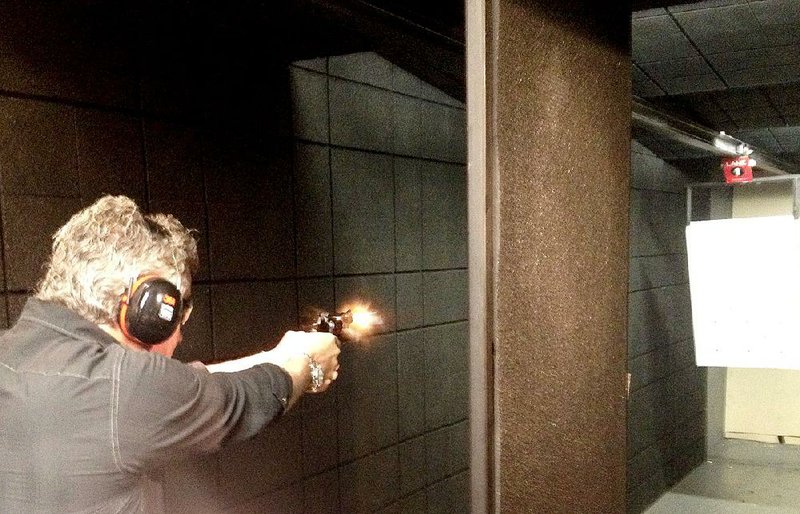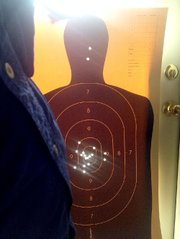PORTLAND, Ore. -- For handgun enthusiasts, a laser sight is as useful as an optical scope is to a rifle shooter.
As a scope does for a rifleman, a laser sight helps a handgunner shoot more accurately and more quickly. It also helps him attain a target quicker than with iron sights, and it allows him to engage a target longer.
Laser sights are generally considered accessories, but one company believes they should be standard equipment on every pistol. To that end, Crimson Trace, based in Wilsonville, Ore., makes laser sights to fit nearly every contemporary civilian and military firearm in existence.
Kent Thomas, marketing director of Crimson Trace, said a laser sight makes every handgunner more competent and more confident. This actualizes the purpose of a self-defense handgun, which is to ensure the safety of its owner.
"We help bad guys make informed decisions," Thomas said.
In 2009, Thomas said, laser sights were represented on only 10 percent of personal protection firearms. He said that Crimson Trace's goal is to make laser sighting systems standard equipment on at least 50 percent of all personal protection handguns sold in the United States over the next five years.
At the beginning of 2013, 15.5 percent of personal protection firearms had laser sights, Thomas said. At the end of 2014, it was 21 percent.
Mike Faw, media relations manager for Crimson Trace, said the popularity of laser sights and other accessories like high-intensity LEDs mirror the overall growth of the firearms industry.
"There have been millions of new firearms purchased since 2008," Faw said. "Many of those guns are sitting in drawers and safes with fewer than 50 rounds fired through them, but more and more owners are saying, 'I've got this thing, I want to use it, and you know what? It's fun to shoot, and I want to shoot it more.'"
Adding laser sights and LEDs is practical, but Faw said gun owners also enjoy accessorizing and customizing their firearms.
A laser sight's benefits are immediately apparent. A tour of Crimson Trace's headquarters and factory last week included a session with the company's armorer in the company's indoor range. The "range" is a converted metal shipping container that contains two shooting lanes with motorized targets that can be set to about 50 feet. The soundproof range is ventilated and has excellent lighting. It contains angular baffles that direct malfired projectiles downrange. Thick, projectile absorbing drywall encases the range.
Our arsenal included, in firing order, a Ruger LCR [revolver] in 38 Special, a Glock 42 semiautomatic in .380 ACP, a Smith & Wesson M&P Shield 9mm semiautomatic and a Glock 34 semiautomatic in 9mm. Each had integral grip lasers that activate by squeezing the grip. The Glock 34 had a rail-mounted laser that requires manual activation. The rail site also has a high-intensity LED. The shooter must flip a switch on a rail sight to activate the laser and light.
The drill was to fire six rounds from the revolver, and then fire full magazines from each of the semiautos as I moved down the line.
The laser sights dramatically demonstrated how much heartbeat and breathing affect the point of aim and impact. All of the guns except the Glock 34 are very small and compact, so even minute movements affect them noticeably. Distance amplifies muzzle movement, too, as does the cumulative effect of high-volume firing in such a short time.
The laser also demonstrates the effect of recoil on point of aim. Photographs showed dramatic laser patterns on the target, but muzzle movement was really conspicuous in video. It looked like someone splashing the target with green or red paint.
The lasers helped minimize muzzle movement by providing an immediate visual reference for point of impact. It forces you to control the firearm, enabling a shooter to place every round very quickly into the targets' lethal zones.
A laser's increased efficiency translates directly to recreational and sport shooting, too. A firearm owner has a responsibility to shoot accurately, whether he's punching holes in paper, shooting steel plates or shooting at animal silhouettes.
In addition to projection lasers like those made by Crimson Trace, you can also buy reflective lasers, or dot sights, to replace iron sights on hunting pistols and rifles. These are commonly used with military and tactical style rifles, but some hunters are replacing optical scopes with high-quality dot sights on their hunting rifles. When sighted in properly, a precision dot sight can turn a rifle into a simple point-and-shoot implement.
Skeptics might argue that a telescopic scope is necessary to identify a target and to determine, for example, whether a buck is legal. Hunter education courses teach against using scopes to scan or identify targets. Binoculars, which do not risk an unintended discharge, are better suited to those tasks.
At hunting distances that do not demand high magnification, a dot site can be excellent alternative to a telescopic sight.
Projected lasers are best suited for handguns, and they make them a whole lot more fun to shoot.
Sports on 04/12/2015


